50 Top Growth Stocks. Blue Harbinger
Market fear has ticked up slightly over the last week as interest rate hikes are expected to resume and some investors believe this could pour cold water on the stock market’s red hot rally so far this year, especially high-growth stocks. However, it is our contention that this short-term noise won’t matter for select top growth stocks which will be driven higher by strong execution supported by incredible disruptive secular trends (including generative AI, the great cloud migration and the world’s insatiable demand for more efficient sources of energy). In this report, we share high-level data on the current state of the market, company-specific fundamental metrics on over 50 top growth stocks, and then review three specific stocks from the list that represent particular compelling businesses going forward, including a special focus on Datadog (NASDAQ:DDOG).
Market Conditions:
Despite the strong gains for the stock market this year (it’s up over 15%) it’s still basically flat over the last two years (as you can see in the chart below).
YCharts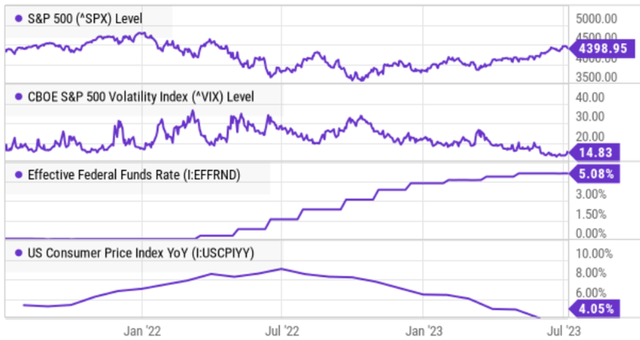
And while some people are increasingly nervous because the market “fear index” (VIX) has ticked up in the last couple weeks (see above), it’s still relatively low by historical standards.
Further, some investors are fearful because the Fed is expected to resume interest rate hikes later this month. However, rates are still reasonably low by historical standards, and rate hikes have been slowing and are expected to increase at a slower pace going forward (as per the latest Fed meeting minutes released this past week), another relatively good thing for the market.
Further still, the high inflation that the Fed is hiking rates to combat (CPI was 9.0% one year ago, see chart above) continues to trend significantly lower (a good sign for investors), and it may revert to the more historically normal ~2% level soon.
And even though some economists are still calling for recession, the economy is stronger than it was two years ago (inflation-adjusted Real GDP is now higher), and the stock market is usually many months ahead of the economy in terms of its health.
YCharts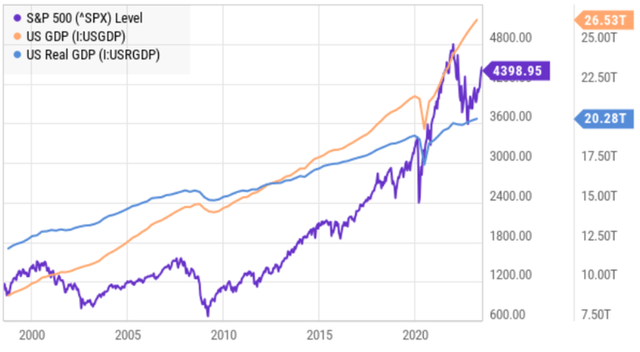
And in another potential good sign, some economists are now saying there will be no recession (or that it already happened and no one noticed), especially following the latest fed meeting minutes released this past week.
So despite the fear some media pundits unrelentingly push, the economy is not in terrible shape, and that clears the way for stocks (some more than others) to perform well going forward.
50 Top Growth Stocks
Top growth stocks (those with high revenue growth rates) can be particularly sensitive to the economy. For example, we share over 50 top revenue growth stocks in the following table, and many of them soared to extremely high levels during the pandemic (as fiscal and monetary stimulus created a very strong tailwind), but then crashed when the pandemic bubble burst (i.e. as monetary and fiscal policies shifted from dovish to hawkish to fight inflation).
To be included in the following table, we required an expected revenue growth rate for next year of at least 15% and a market cap of at least $3 billion. The table is sorted by market cap (and we also included a handful of big tech names for comparison purposes). As you can see, the year-to-date returns have been very strong for many of these names (i.e. they are up much more than the S&P 500), but many of the 2-year returns are still terrible (as the 2-year number captures a significant portion of the pandemic bubble bursting).
data as of Fri 7-Jul-23 (Stock Rover) data as of Fri 7-Jul-23 (Stock Rover)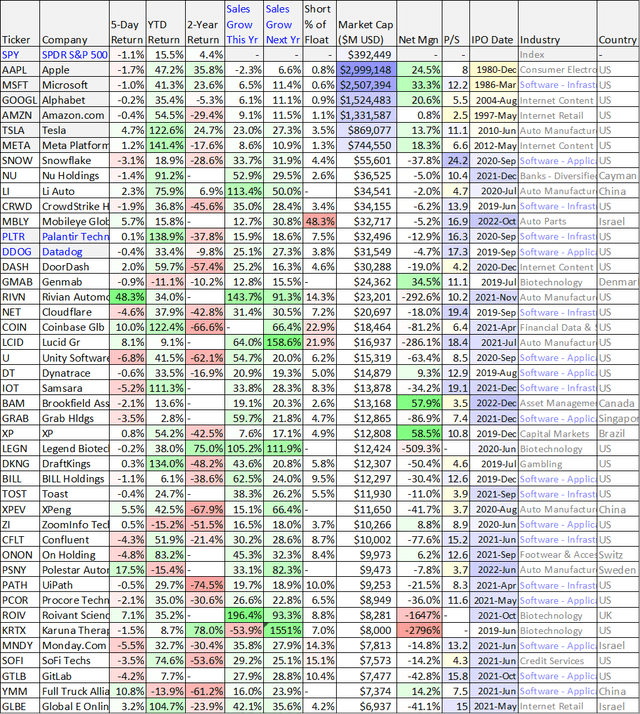
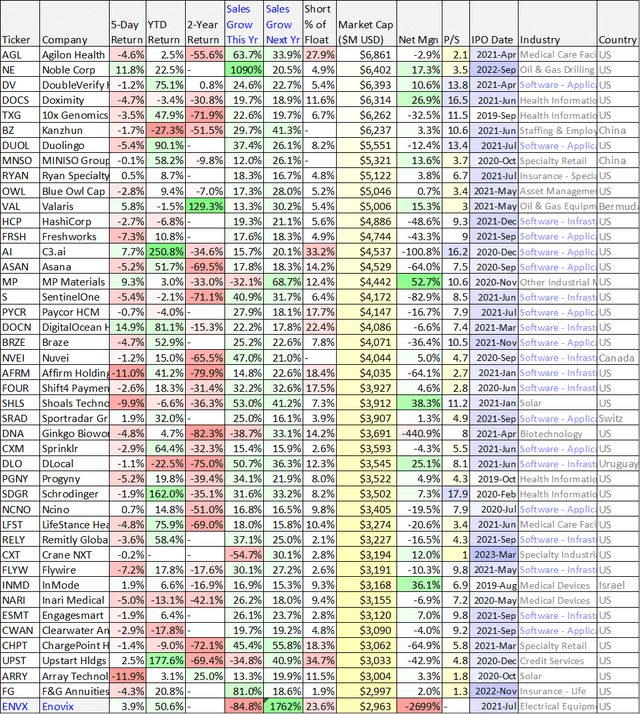
(META) (GOOGL) (AAPL) (AMZN) (MSFT) (TSLA) (DDOG) (PLTR) (ENVX) (SPY) (SNOW) (MBLY) (NU) (NET) (U) (SOFI) (AI) (DLO)
A few more things worth noting about the stocks in the table, many of them began trading publicly in the last few years as you can see the “Initial Public Offering” date column (because the companies wisely offered their shares publicly when valuations were high), and many of them are not yet profitable as you can see in the “Net Margin” column (something that can be particularly challenging in a rising interest rate environment, thus the big price drops over the last two years).
The table also includes price-to-sales ratios (if this valuation metric is over 10x then the company better have some pretty extraordinary growth opportunities to support it), and recent short-interest amounts (representing people betting against the stock, those with very high short interest could experience strong price gains if the market keeps going higher and short sellers are forced to buy back the shares thereby putting upward pressure on the price in what is known as a “short squeeze”).
Lastly, you can see many of these high growth stocks are in the software industry (software is “eating the world”) and most of them are based in the United States.
Three (3) Top Growth Stocks Worth Considering
The three specific stocks we review next all have very high expected growth rates, they’re all benefiting from a powerful secular trend (including artificial intelligence, the great cloud migration and/or the world’s insatiable demand for efficient energy sources), they’re all relatively recent IPOs (in the last few years) and despite this year’s very strong gains-they’re all trading dramatically lower than their all-time highs. And importantly, all three businesses continue to improve significantly from a fundamental standpoint.
1. Datadog (DDOG):
Datadog
Datadog is a particularly attractive high-growth business from the 50+ stock list above, and the company is on track to keep growing revenue rapidly thanks to the great cloud migration. And even though the shares are up significantly this year, they are well below their all-time high, and have dramatically more upside potential in the years ahead.
YCharts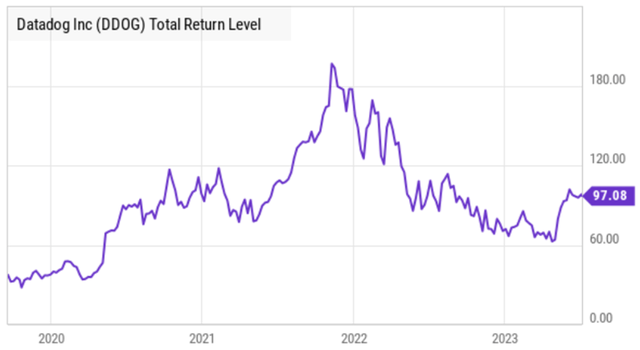
Datadog Overview:
Datadog provides a cloud-based monitoring and analytics platform that helps organizations monitor their infrastructure, applications, and services in real-time. This Software as a Service (“SaaS”) platform delivers a unified solution for the complete technology stack for its customers by integrating and automating various capabilities (such as infrastructure monitoring, application performance monitoring, log management, real-user monitoring, and more).
Datadog’s proprietary platform, which allows diverse data types from over 600 integrations, provides a holistic view of an organization’s infrastructure and application performance. Datadog’s services are utilized by businesses of various sizes and across various industries and its platform plays a crucial role in facilitating the digital transformation and cloud migration efforts of its customers.
Investor Presentation Source: Investor Presentation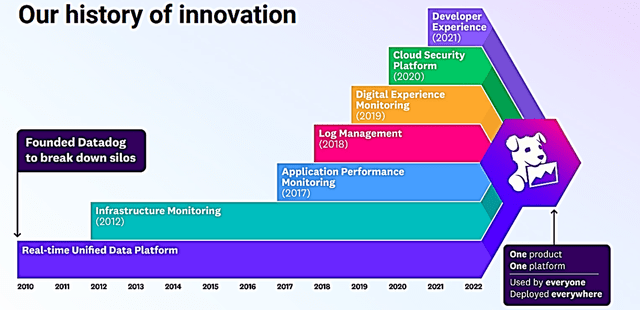
The company generates revenue primarily by selling subscriptions to customers who utilize its cloud-based platform. The subscription agreements typically have monthly or annual terms. Geographically, it derived 71% of its revenues from North America, with the remaining revenues come from other international markets (including Amsterdam, Dublin, London, Paris, Seoul, Singapore, Sydney, and Tokyo; plus plans to expand in EMEA and APAC) in Q1 2023 as shown in the chart below.
Company 10-Q Source: Company’s 10-Q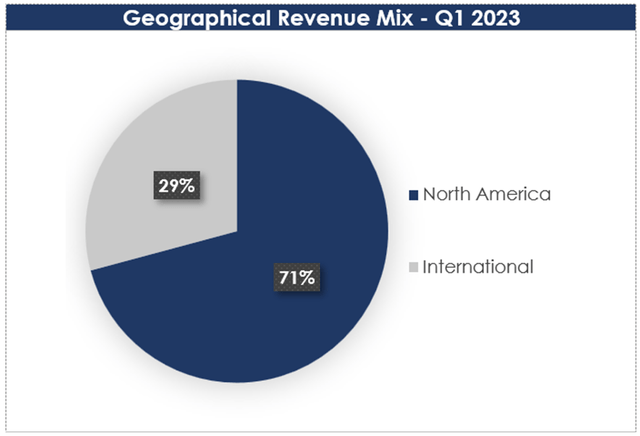
Datadog’s Land & Expand Strategy: Driving Sticky Growth Through a Comprehensive Product Portfolio
A “land & expand” strategy (such as the one used by Datadog) involves acquiring customers by getting them to make a small purchase and gradually increasing their commitment over time. It is closely tied to a company’s product portfolio strategy, where additional products or services are introduced to expand customer engagement and meet a wider range of needs. This approach enables cross-selling and upselling opportunities, driving customer satisfaction and revenue growth.
Datadog (initially focused on only infrastructure monitoring) now offers a comprehensive monitoring and analytics solution for observability, security, and developer insights. Additionally, the company utilizes AI and machine learning to enhance its monitoring and observability capabilities, allowing customers to gain valuable insights from the vast amounts of data it observes.
The company’s business model prioritizes easily adoptable products for fast value delivery, driving innovation with a portfolio of more than 17 products. Its land & expand strategy, combined with its extensive product portfolio, gives it a competitive advantage over specialized competitors. By continuously expanding its product offerings and consistently delivering value throughout the customer journey, Datadog has successfully deepened its foothold within its existing customer base while attracting new customers.
Investor Presentation Source: Investors Presentation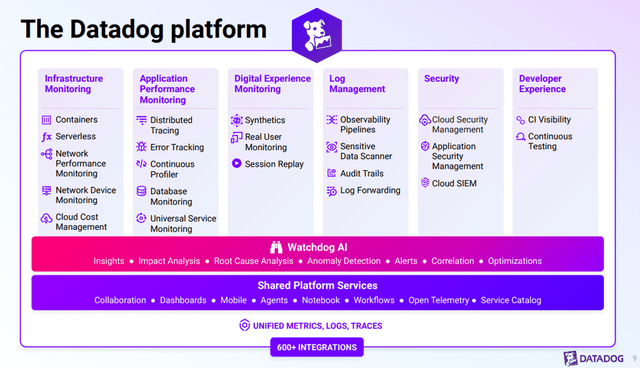
Datadog’s Strong Dollar-Based Net Retention Rate and Increasing Product Adoption Reflect Growing Product Engagement
Datadog’s dollar-based net retention rate exceeded 130% as of March 31, 2023, and March 31, 2022. This rate demonstrates the company’s success in increasing product adoption, cross-selling, upselling, and customer loyalty. It signifies that the company’s revenue growth is not solely dependent on acquiring new customers.
In Q1 2023, approximately 81% of Datadog’s customers used multiple products, indicating a higher level of engagement. Moreover, around 43% utilized more than four products (compared to 35% in Q1 2022), and about 19% used more than six products (up from 12% in Q1 2022), highlighting strong growth in product adoption. For example, you can view this data in the charts below.
data: Investor Presentation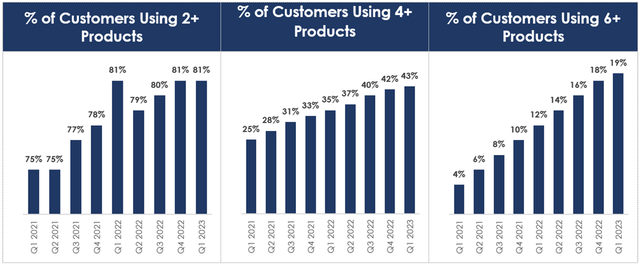
Datadog’s Strong Growth in Customer Base and Revenue Contribution from High-Value Customers Provides Revenue Stability
In Q1 2023, Datadog experienced substantial growth in its customer base, which reached approximately 25,500 compared to around 19,800 in Q1 2022. This increase reflects the growing demand for the company’s products. Moreover, the number of customers generating Annual Recurring Revenue (“ARR”) of $100,000 or more rose to around 2,910 by the end of Q1 2023, compared to approximately 2,250 in Q1 2022. This demonstrates an upward trend in high-value customers and their increased investment in Datadog’s offerings. It is noteworthy that the percentage of total ARR contributed by customers with ARR of $100,000 or more has increased substantially, rising from 60% in 2017 to 85% in Q1 2023. This strong revenue contribution from large customers provides stability during market fluctuations, as these customers are generally less impacted by short-term macro factors compared to smaller customers or Small and Medium-Sized Businesses (SMBs). This reinforces Datadog’s position in the industry and enhances its ability to navigate market dynamics.
data: Investor Presentation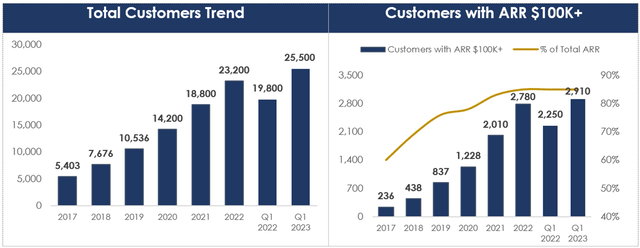
Embracing the Secular Tailwind of Digital Transformation and Cloud Migration in Growing Total Addressable Market (TAM)
Gartner estimates that more than half of Enterprise IT spending (within the application software, infrastructure software, business process services and system infrastructure markets) will shift to the cloud by 2025. The data suggests that approximately 51% of IT spending (or $917B in dollar-terms in the aforementioned markets) will transition from traditional on-premises solutions to cloud solutions. This represents a notable increase from the 41% recorded in 2022. And as the trend towards cloud adoption continues to accelerate, Datadog is well-positioned to benefit from this paradigm shift and meet the increasing demand for its cloud-based offerings.
data: Gartner Source: Gartner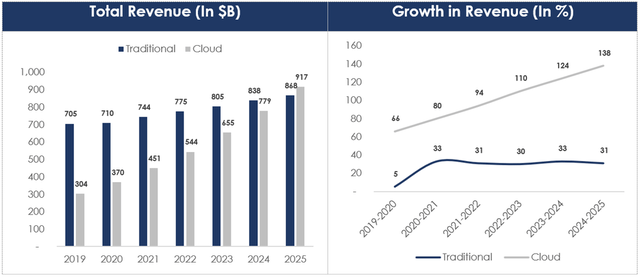
The company’s platform is well-positioned to seize a significant share of the IT Operations Management market, which is projected to reach a value of $62B by 2026. The company acknowledges that a considerable portion of this market comprises legacy on-premise and private cloud setups. However, it believes that the estimate doesn’t fully account for the potential in modern multi-cloud and hybrid cloud environments. With a platform specifically tailored to address both legacy and modern setups, Datadog demonstrates its readiness to meet the evolving demands of IT Operations Management across diverse cloud environments.
data: Investor Presentation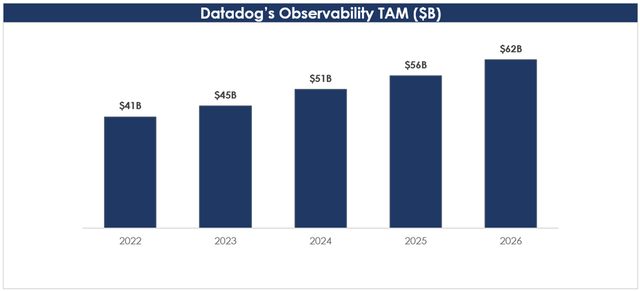
Machine Learning and Generative AI
Also worth mentioning explicitly, Datadog is a good fit with (and set to benefit from) machine learning and generative AI (artificial intelligence) which have been hot topics in recent quarters. The topic was covered at the annual William Blair Growth Stock Conference where Datadog CFO David Obstler was interviewed, and had this to say about the topic:
We’ve always been a very good fit with machine learning and AI and data companies. We highlighted one of those in the earnings call, we didn’t give the name but one of the companies that’s providing technology.
And to the extent that there’s more traction in those type of companies, they are excellent fits with Datadog and we’ll see accelerated growth in those customers. So that’s outward-facing. Now inward-facing to Datadog, we have begun to look at ways that we can use the product internally to speed up our software development or produce marketing collateral faster. We’re early on but we’re optimistic like others are that there will be use cases inside Datadog that will help us become more efficient, churn out more software, churn out more marketing — marketing collateral, etcetera.
In our view, Datadog should benefit from its accelerating client use cases related to machine learning and generative AI.
Datadog Prioritizes Revenue Growth Over Profit Margins to Expand Platform Capabilities
In Q1 2023, the company’s revenue grew 33% YoY to $481.7M, driven by a combination of an expanding customer base and increased adoption of multiple products. Notably, 65% of this growth was attributed to expansion from existing customers, while the remaining 35% stemmed from the addition of ~5,700 new customers in Q1 2023. Additionally, the Remaining Performance Obligations (RPOs) grew 33% YoY in Q1 2023 to $1.1B, indicating a strong revenue pipeline.
On the profitability front, non-GAAP gross profit increased 33% YoY to $387.6M in Q1 2023. However, the gross profit margin remained steady at 81% led by revenue growing in proportion to the growth of third-party cloud infrastructure provider costs to facilitate more customers on the platform.
Company Filings
In Q1 2023, the company’s non-GAAP operating profit showed modest YoY growth of 3%, reaching $86.4M. However, the operating profit margin experienced a decline of 500 basis points (bps) YoY, dropping from 23% in Q1 2022 to 18% in Q1 2023. This decrease can be attributed to higher Research and Development (R&D) spending. Datadog has been increasing its R&D spending to expand its platform and product capabilities, given its early stage in the business cycle. In fact, the percentage of non-GAAP R&D expense to revenue has grown from 27% in 2018 to 31% in the Trailing Twelve Months (“TTM”) ended March 2023, highlighting significant investments made by the company.
On the other hand, non-GAAP Sales & Marketing (S&M) expenses as a % of revenue have experienced a steep decline, from 44% in 2018 to 25% in the TTM ended March 2023, showcasing Datadog’s success with its land & expands strategy, along with the extensive capabilities of its product portfolio, driving word-of-mouth presence.
Company Filings
Healthy Balance Sheet with Sequential Improvement in Free Cash Flow Generation
Datadog’s liquidity position at the end of Q1 2023 was strong, with $2.0B in total, consisting of $223M in cash and cash equivalents, as well as $1.8B in marketable securities. Importantly, the company had no significant long-term debt, giving it flexibility for future investments and growth initiatives.
In terms of cash flow, the company experienced a 9% YoY decline in Cash Flow from Operations (“CFO”) in Q1 2023, amounting to $133.8M compared to $147.4M in Q1 2022. This decrease was primarily due to lower profitability during the period. Free Cash Flow (“FCF”) also declined by 10% YoY in Q1 2023, reaching $116.3M compared to $129.9M in Q1 2022. Despite the decline, the company’s liquidity position and absence of major long-term debt provide a strong foundation for financial stability and growth.
data: Company Filings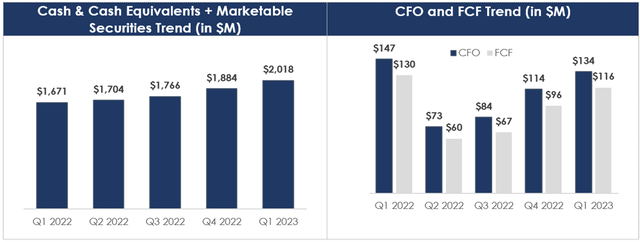
Datadog Valuation:
Despite experiencing a 35% year-to-date increase, the company’s stock is still nearly 50% below its all-time high in 2021. While the near to medium-term macroeconomic conditions remain uncertain due to concerns such as rising rates and potential recession, the company’s sticky platform, along with a substantial revenue contribution from large customers, provide a safeguard against evolving challenges. In terms of valuation, the company’s forward sales multiple is currently at 14.9x, which is in line with its peers but represents a significant discount compared to its 5-year average. Overall, we believe the risk-reward ratio is attractive for investors.
Seeking Alpha
(SNOW) (CRWD)
Datadog Risks:
Intense competition: The global market for monitoring and analytics has been fiercely competitive for many years, with each company offering its distinct features and strengths to meet the diverse needs of customers. Datadog faces competition from industry giants like IBM, Microsoft Corporation, SolarWinds Corporation, Cisco Systems, as well as New Relic, Dynatrace Software, Splunk, Elastic N.V., Amazon (specifically, Amazon Web Services), and Google (for Google Cloud Platform). Despite this intense competition, Datadog has been recognized as a leader in the industry by both Gartner and Forrester. In recent reports, Datadog was ranked as a leader in Application Performance Monitoring and Observability by Gartner, and in AI (artificial intelligence) for IT operations by Forrester. These rankings highlight the company’s strengths and its ability to provide effective solutions to meet customer needs in a competitive landscape.
Investor Presentation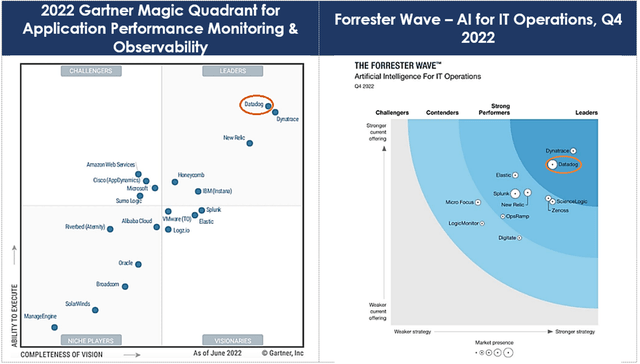
Datadog Takeaways:
Datadog is well-positioned for long-term growth, leveraging its effective land and expand model, robust platform capabilities, and strong customer retention. These factors enable the company to capitalize on the ongoing secular digital transformation trend. Despite being a high-growth technology company, Datadog has also maintained a solid balance sheet with minimal debt and a strong cash flow generation profile.
Again, there may be some near-term uncertainties regarding recessionary concerns (which could impact revenue growth and margins), but Datadog’s financially strong customer base and comprehensive platform capabilities provide a foundation for resilience and long-term success. We view this as an attractive opportunity for patient, long-term investors.
2. Palantir (PLTR)
Palantir
Palantir is basically a software company, and it is positioned to benefit dramatically in the years ahead from the massive secular growth in Artificial Intelligence (“AI”) and Machine Learning (“ML”) (especially thanks to the company’s leading solutions, innovation, sticky customer base and very strong balance sheet).
YCharts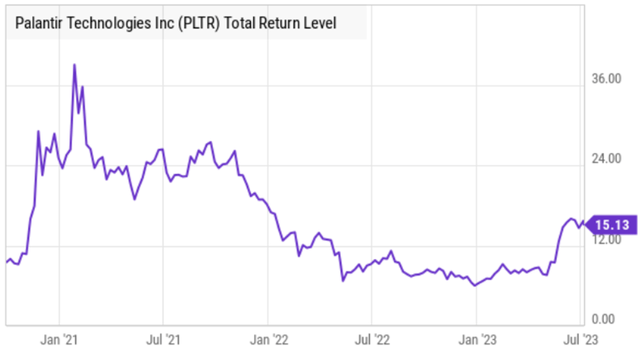
Palantir is a “busted pandemic-era IPO.” Specifically, the stock was loved (during the pandemic bubble) then hated (when the bubble burst), but the business has only been getting stronger and the shares are still inexpensive relative to where we expect them to be in five years and beyond. In the following report, we review the business, the growth, the opportunity, the valuation and the risks. We are currently long these shares with no intention of selling. And for more information, check out our recent detailed full report titled “Palantir: Big Secular AI Growth.”
3. Enovix (ENVX)
Enovix
This is the most speculative idea on our list, and potentially the most lucrative (if things continue to progress for the company). Enovix is a manufacturer of advanced lithium-ion batteries. And this “early-stage public company” (it’s a “busted pandemic IPO stock) is well-positioned to benefit from growing demand, including mobile, Internet of Things (“IoT”) and electric vehicles. What sets Enovix apart (versus the competition) is its energy density advantage (achieved through design and architecture choices) and silicon anode technology (learn more in our full report linked below). Importantly, Enovix also addresses key safety concerns.
YCharts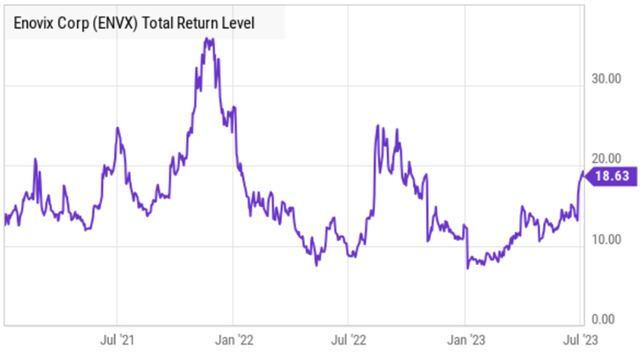
Here (below) is our full report, whereby we review the business model, market opportunity, financials, valuation and risks. If you can handle this stock’s very high risk-reward profile, the shares are absolutely worth considering. We are long Enovix. For more information, check out our recent detailed full report titled “Enovix: Big Disruptive Growth.”
Conclusion:
The economy continues to improve as inflation slows, interest rate hikes moderate and GDP continues to climb higher. Of course conditions are always dynamic and near-term volatility can be frustrating, but over the long-term we believe an improving economy will continue to drive the stock market higher.
The specific high-growth stocks described in this report are particularly attractive (enough to rank them in our recent Top 10 growth stock report) because of their high revenue growth trajectory, continuing fundamental improvements and the strong secular trends that support them. We currently own all three, and consider Datadog especially attractive.
However, at the end of the day, you need to select only investment opportunities that are right for you (growth stock investing is absolutely not right for everyone), based on your own individual situation. We believe disciplined, goal-focused, long-term investing will continue to be a winning strategy.
Read the full article here




